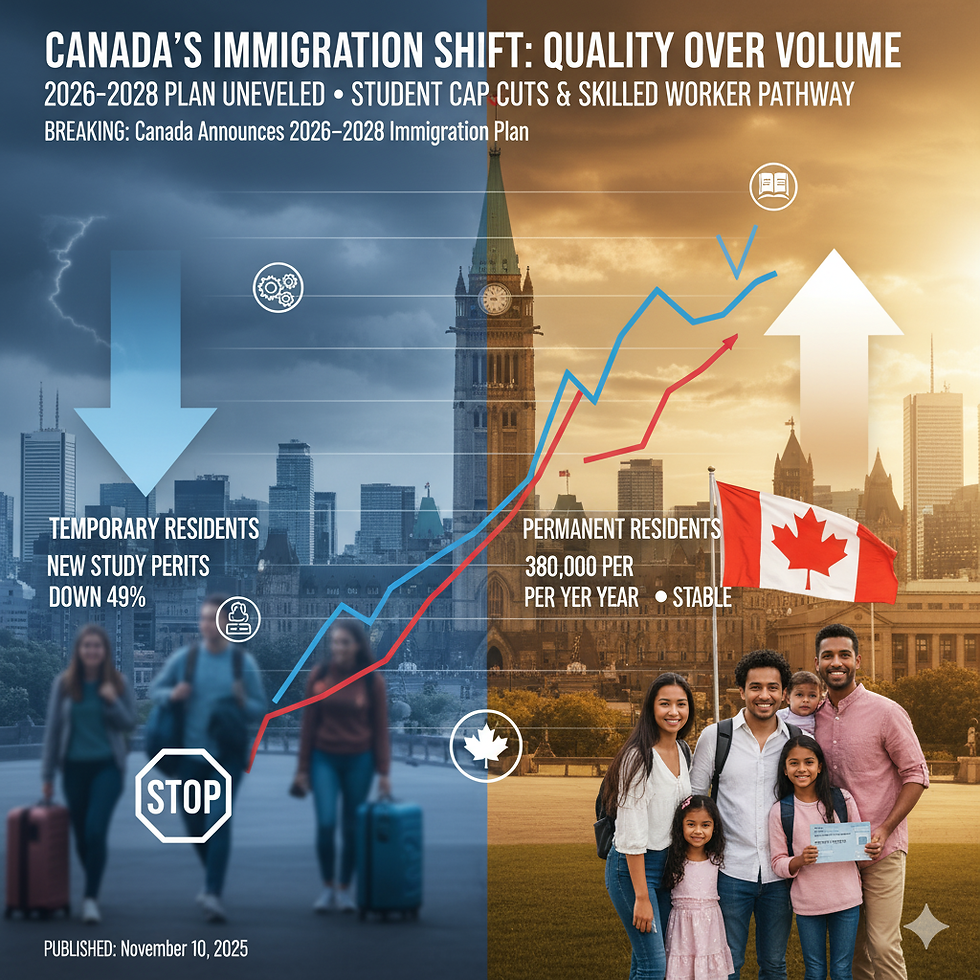Understanding Canada's Temporary Foreign Worker Program
- Ansari Immigration

- Aug 26, 2024
- 5 min read
Purpose | Allows employers to hire foreign nationals for positions not filled by Canadians |
Established | 1973 |
Initial Target Workers | High-skilled workers such as nurses and medical specialists |
Current Workforce | Over 775,000 temporary foreign workers |
Workforce Percentage | Represents 4% of Canada's workforce |
Majority Employment Sector | Low-prestige jobs, such as fast food workers |
Expansion and Changes | Added low-skilled workers category in 2002; expanded with fast-tracking in 2006; revised in 2013 to raise wages and charge employer fees |
The Temporary Foreign Worker Program (TFWP) is a critical component of Canada's immigration and employment landscape. This program allows Canadian employers to hire foreign nationals to fill temporary jobs when qualified Canadian citizens or permanent residents are not available. The program is designed to address labor shortages and support economic growth by bringing in workers from abroad to fill roles that are essential to various sectors of the economy.

An Overview of the Temporary Foreign Worker Program
The TFWP is administered by Employment and Social Development Canada (ESDC) in partnership with Immigration, Refugees and Citizenship Canada (IRCC) and the Canada Border Services Agency (CBSA). It is regulated under the Immigration and Refugee Protection Act and its associated regulations. The program is designed to be responsive to labor market needs and is structured to ensure that the employment of foreign workers does not negatively impact the Canadian labor market.
Types of Workers and Streams
The TFWP encompasses several streams, each designed to address specific labor needs:
High-Wage Workers: This stream is for positions where the wage offered is at or above the provincial or territorial median wage. Employers must submit a Labour Market Impact Assessment (LMIA) to demonstrate the need for a foreign worker.
Low-Wage Workers: For positions where the wage is below the median. Employers are subject to caps on the number of foreign workers they can hire and must provide transportation, housing, and workplace safety measures.
Seasonal Agricultural Worker Program (SAWP): This stream allows employers to hire temporary foreign workers from specific countries for agricultural work. It is crucial for sectors like farming, where labor shortages are common.
Global Talent Stream: Part of the Global Skills Strategy, this stream is designed to help Canadian employers attract highly skilled global talent. It features faster processing times and is aimed at sectors like technology.

Application Process and Requirements
To hire a temporary foreign worker, Canadian employers must obtain a positive LMIA. This process involves proving that there is a need for a foreign worker and that no Canadian worker is available to do the job. The LMIA assesses factors such as the impact on the Canadian labor market, recruitment efforts, and working conditions offered.Workers must have a valid work permit to enter Canada under the TFWP. This permit is tied to the specific employer and job, meaning that workers cannot freely change jobs without obtaining a new permit.
Rights and Protections for Workers
Temporary foreign workers in Canada have the same employment rights as Canadian citizens. They are entitled to fair wages, safe working conditions, and protection from abuse. Employers are required to provide health insurance if provincial or territorial health coverage is not available from the first day of work.The Canadian government has implemented measures to protect temporary foreign workers, including a tip line for reporting mistreatment and regulations prohibiting employers from charging recruitment fees or retaliating against workers who exercise their rights.
Challenges and Criticisms
Despite its benefits, the TFWP has faced criticism and challenges:
Worker Exploitation: There have been reports of abuse and exploitation, including cases where workers were confined to their housing or faced unfair treatment.
Impact on Local Workers: Critics argue that the program can undermine local labor markets by allowing employers to bypass Canadian workers in favor of cheaper foreign labor.
Administrative Burden: The process of obtaining an LMIA and hiring foreign workers can be complex and time-consuming for employers.

Recent Developments
The Canadian government has introduced initiatives like the Recognized Employer Pilot (REP) to streamline the process for employers who have a history of compliance with TFWP regulations. This pilot aims to reduce administrative burdens and improve planning for staffing needs by allowing longer validity periods for LMIAs.
Frequently Asked Questions
1. What documentation do temporary foreign workers need to enter Canada?
Temporary foreign workers need a valid passport, a work permit or a port of entry letter of introduction, and contact information for both themselves and their employer.
2. Are temporary foreign workers entitled to health care in Canada?
Yes, temporary foreign workers should receive health care coverage equivalent to other residents. If provincial coverage is not immediately available, employers must provide private health insurance.
3. Can an employer restrict a temporary foreign worker's movement?
No, employers cannot legally restrict a worker's movement. Such actions may be considered abuse under Canadian regulations.

What are the eligibility requirements for temporary foreign workers to enter Canada
To be eligible to enter Canada as a temporary foreign worker under the Temporary Foreign Worker Program (TFWP), several requirements must be met:
Job Offer: Applicants must have a valid job offer from a Canadian employer. The job offer is a critical component, as it forms the basis for the work permit application.
Labour Market Impact Assessment (LMIA): In most cases, the Canadian employer must obtain a positive LMIA, which confirms that there is a need for a foreign worker to fill the job and that no Canadian worker is available to do it. The LMIA is a document issued by Employment and Social Development Canada (ESDC) that assesses the impact of hiring a foreign worker on the Canadian labor market.
Work Permit: A work permit is required to work legally in Canada. This permit is usually tied to the specific employer and job, meaning that workers cannot change jobs without obtaining a new permit.
Proof of Intent to Leave Canada: Applicants must demonstrate that they will leave Canada once their work permit expires. This is a crucial requirement to ensure that the temporary nature of the work is respected.
Financial Stability: Applicants must prove that they have sufficient funds to support themselves and their family during their stay in Canada and to return to their home country after their work permit expires.
Clean Criminal Record: A clean criminal record is necessary to ensure that the applicant is not inadmissible to Canada for security reasons.
Health Requirements: Applicants must be in good health and may need to undergo a medical examination to prove this.
Employer Restrictions: Applicants must not work for employers who offer services such as striptease, erotic dance, erotic massage, or escort services.
Additional Documentation: Depending on the applicant's country of citizenship, a Temporary Residence Visa (TRV) or an Electronic Travel Authorization (eTA) may be required. Additionally, applicants must have a valid passport and contact information for both themselves and their employer.
Meeting these requirements is essential for the successful application and entry into Canada under the TFWP. It is important for applicants to carefully prepare their documentation and ensure compliance with all regulations to avoid any issues during the application process.




Comments